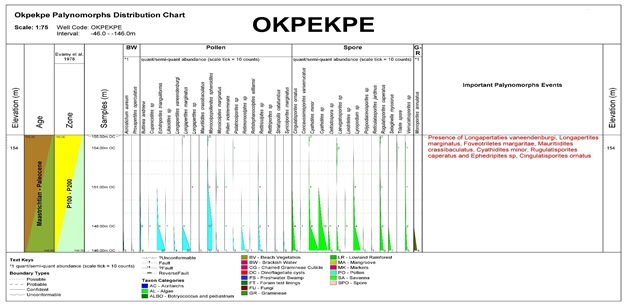Evaluation of the Hydrocarbon Potentials of Shale Exposures at Okpekpe in Edo North
DOI:
https://doi.org/10.25299/jgeet.2019.4.4.2807Keywords:
Organic-Geochemistry, Biostratigraphy, Source-Rock, Okpekpe, Anambra-BasinAbstract
This study evaluates the source rock characteristics of rock exposures along a newly exposed road cut in Okpekpe. An integrated technique of organic geochemical analysis and biostratigraphy evaluation were adopted to determine the source rock quality, Maturation index, kerogen types, depositional environment andsediment age.
Results of organic geochemistry gave total organic carbon (TOC) value between 0.81 to 3.04 w.t% (2.08wt.% average) indicative of a good source potentials. The plot of Total Sulphur Content (TSC) against TOC suggests a transitional depositional environment for the samples while the plot of hydrogen index (HI) against oxygen index (OI) shows that the samples are capable of generating mixed type II/III kerogen.
Palynological analysis revealed that the basal section of the exposure is characterized by the occurrences of typical and moderately rich Late Cretaceous – Early Tertiary palynomorphs. While the upper section is poorly rich in palynomorph abundance but with spot occurrences. The palynomophs asssemlages is of Late Maastrichtian - Early Paleocene and the outcrop is characterized by the presence of terrestrial pollens and spores indicating a continental to transitional depositional environment, typical of the Mamu Formation of the Anambra Basin.
Downloads
References
Akaegbobi, I. M., Nwachukwu, J. I, Schmitt, M., 2000. Aromatic hydrocarbon distribution and calculation of oil and gas volumes in post-Santonian shale and coal, Anambra Basin, Nigeria In: Petroleum systems of South Atlantic margins. Amer.73, 233-245.
Akande, S.O., Ojo, O.J., Erdtmann, B.D., Hetenyi, M., 2005. Paleoenvironments, Organic Petrology and Rock – Eval Studies on Source Rock Facies of the Lower Maastrichtian Patti Formation, Southern Bida Basin, Nigeria. Journal of African Earth Sciences 41, 394-406.
Akande, G.W., 2012. Evaluation of Hydrocarbon Generation Potential of the Mesozoic Organic-Rich Rocks Using TOC Content and Rock-Eval Pyrolysis Techniques. Geosciences 2(6), 164-169.
Babatunde, O.L., 2010. The main oil source formations of the Anambra Basin, Southeastern Nigeria. AAPG International Convention & Exhibition, September, 12-15.
Burke, K.C., Dessauvagie, T.F.J., Whiteman, A.J., 1972. Geological history of the Benue valley and adjacent areas, University of Ibadan Press, Nigeria.
Dow, W. G., Kamata, H., Suizu, M., 1992. The art of maturity modeling: Part 1. Finding a satisfactory geological model. AAPG Bulletin 76, 31 – 46.
Edegbai, A. J., Emofurieta, W. O., 2015. Preliminary assessment of source rock potential and palynofacies analysis of Maastrichtian dark shale, SW Anambra. Ife Journal of Science 17(1), 131-139.
Espitalie, J., Deroo, G., Marquis, F., 1985. Rock Eval pyrolysis and its Applications. Institute Francais du Petrole , France.
Hunt, J. M., 1979. Petroleum Geochemistry and Geology:W. H. Freeman, San Francisco, USA.
Katz, B., 1995. Petroleum Source Rocks: Springer-Verlag, Houston, USA.
Ladipo, K.O., 1988. Paleogeography, sedimentation and tectonics of Upper Cretaceous Anambra Basin, southeastern Nigeria. Journal of African Earth Sciences 7(5/6), 865 – 871.
Laughrey, C. D., 2009. Applied Petroleum Geology and Geochemistry for thermogenic shale gas evaluation,Weatherford Laboratories, Golden, Colorado, USA.
Legoux,O., 1978. Quelques espèces e pollen caractéristiques du Neogene du Nigeria. Bull. Cent. Rech. Explor. Elf Aquit. 2(2), 265-317
Leventhal, J.S., 1983. An interpretation of carbon and sulfur relationships in Black Sea sediments as indicators of environments of deposition. Geochimica et Cosmochimica Acta 47, 133–137.
Miles, J.A., 1989. Illustrated glossary of petroleum geochemistry. Oxford Univ. Press. U.K.
Nton, M. E., Bankole, S. A., 2013. Sedimentological characteristics, provenance and hydrocarbon Potential of post Santonian sediments in Anambra Basin, southeastern Nigeria: RMZ-Materials and Geoenvironment Journal 60(1), 47-66.
Nwajide, C. S., Reijers, T. J. A., 1996. Geology of the southern Anambra Basin. selected chapters on Geology, SPDC, Warri:133-148.
Nwajide C. S., 2005. Anambra Basin of Nigeria: Synoptic Basin Analysis as a Basis for Evaluating its Hydrocarbon Prospectivity. In Hydrocarbon Potentials of the Anambra Basin; Geology, Geochemistry and Geohistory Perspectives. Great AP Express Publ., Ltd., Nigeria.
Obaje N.G., 2009. The Benue Trough Geology and Mineral Resources of Nigeria. Springer, Berlin, Heidelberg, 57-68.
Ogala, J. E., 2011. Hydrocarbon potentials of The Upper Cretaceous coal and shale units in the Anambra Basin, Southeastern Nigeria. Petroleum and Coal 53(1),35 – 44.
Ogbamikhumi, A., Igbinigie, N. S., Aiworo, O. E., 2017. Organic Geochemical Evaluation for Source Rock Potentials of Mamu Formation Exposed at The Benin Flank of Anambra Basin. Indo-Iranian Journal of Scientific Research (IIJSR) 1(1), 41-45.
Ogbamikhumi,A., Igbinigie, N.S., 2017. Palynological and Organic Geochemical Studies for SourceRock Characterisation and Evaluation of Mamu Formation in the Benin Flank of the Anambra Basin, The International Journal of Engineering and Science (IJES) 6(10), 55-60.
Ola, P. S., Adeoti, B., 2017. Palynomorphs of the First Down-Hole Shale Occurrence in Three Contiguous Basins in Nigeria: Implication on the K-Pg Boundary. Geosciences Research, 2(3).
Peters, K. E., 1986. Guidelines for evaluating petroleum source rock using programmed pyrolysis.American Association of Petroleum Geologists, Bulletin. 70(3), 318 – 329.
Peters, K. E., Cassa, M. R., 1994. Applied Source Rock Geochemistry. In: The Petroleum System – From Source to Trap AAPG Memoir, 60, Tulsa, OK, 93-117
Shrank, E., 1984. Organic geochemical and palynological studies of Dekhia shales profile (Late Cretaceous) in southern Egypt. Berliner geowiss, Abh., 50, 189-207.
Tissot, B., Welte, D., 1984. Petroleum Formation and Occurrence (2nd Ed.): Springer-Verlag, Berlin.
Traverse, A., 1988. Palaeopalynology: Unwin Hyman, London.
Wood, G.D., Gabriel, A.M., Lawson, J.C., 1996. Palynological techniques—processing and microscopy. In: Palynology: principles and applications. American Association of Stratigraphic Palynologists Foundation, Dallas 1, 29–50.

Downloads
Published
Issue
Section
License
Copyright @2019. This is an open-access article distributed under the terms of the Creative Commons Attribution-ShareAlike 4.0 International License which permits unrestricted use, distribution, and reproduction in any medium. Copyrights of all materials published in JGEET are freely available without charge to users or / institution. Users are allowed to read, download, copy, distribute, search, or link to full-text articles in this journal without asking by giving appropriate credit, provide a link to the license, and indicate if changes were made. All of the remix, transform, or build upon the material must distribute the contributions under the same license as the original.










